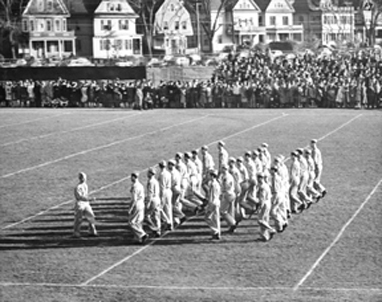|
Tufts and the V-12 Program: “Leadership for a Lifetime”
This is the fourth exhibit at Tisch Library chronicling the Navy’s
relationship with Tufts, from 1941-1972.
Tufts and the U.S. Navy had a close and productive relationship from
1941 to 1972. It began when President Leonard Carmichael fought for
the establishment of a Naval Reserve Officer Training Corps (NROTC)
program at Tufts. The first 100 enrollees were from the entering class
of 1945, while the second class of entering students, the class of 1946,
doubled the size of the NROTC. The standards were high, both mental
and physical, paralleling those required for entrance to the United
States Naval Academy.

NROTC students were placed in class V-1, USNR on inactive duty and
took one course each semester in Naval Science and Tactics as the NROTC
"department" was called. In addition, there was a weekly drill
day where the uniforms of NROTC midshipmen were worn and practical naval
activities, such as signaling, gunnery, and shiphandling, as well as
military drills, were practiced.
The NROTC was a vital program to Tufts prior to the war. With the start
of World War II, life on the Tufts campus changed dramatically. Large
numbers of male students left for military service, while some finished
their remaining semesters before being commissioned for active duty.
Tufts' campus was largely transformed into a Naval Training Center,
altering its dormitories, dining, and athletic facilities to accommodate
the new students.
In the spring of 1943, the Navy Department announced a new nationwide
officer training program. Tufts College was once again among the institutions
selected. The School for War Service was established and facilitated
the Navy College Training Program. The Tufts USNR class V-1, including
the NROTC, were to be put on active duty and incorporated into the V-12
program on July 1, 1943.
 V-12
students sent to Tufts from other universities and enlisted sailors
from the Atlantic and Pacific fleets were also placed on active duty
in the United States Navy on the Tufts campus. Initially, the U.S. Naval
V-12 regiment consisted of over 1,000 men. When the active duty program
ended in June 1946, over 2,000 officer candidates had been trained at
Tufts. V-12
students sent to Tufts from other universities and enlisted sailors
from the Atlantic and Pacific fleets were also placed on active duty
in the United States Navy on the Tufts campus. Initially, the U.S. Naval
V-12 regiment consisted of over 1,000 men. When the active duty program
ended in June 1946, over 2,000 officer candidates had been trained at
Tufts.
NROTC students were commissioned as ensigns in the USNR or 2nd Lieutenants
in the USMCR (Marines), while V-12 students were commissioned after
Midshipman’s School or Flight Training. They were sent to the
fleet as commission officers.
Many V-12/NROTC students were assigned to the Amphibious Navy, including
to Landing Ship Tanks. Tufts students were well represented in major
battles across the Pacific such as Lingayen Gulf on the island of Luzon,
Saipan, the invasions of the Philippines, Iwo Jima, and Okinawa and
in the occupation of Japan. Some also served in the Atlantic, in Europe
at Normandy in 1944, and other battle sites. Almost half of the members
of the classes of 1945 and 1946 had some involvement at Okinawa, one
of the most fiercely fought battles of World War II.
Most of the V-12/NROTC students were separated from the Navy with the
end of the World War II after Japan’s surrender on August 15 of
1945 and returned to Tufts to complete their interrupted educations.
Some did not end the relationship with the regular Navy and had involvement
with the Naval Reserve. Several retired from the Navy as lieutenant
commanders, commanders, captains ,
and one as admiral. For example, Peter Merenda, Fran McCarran, Dick
Rome, and Warren Jackson attained the rank of captain in the Naval Reserve. ,
and one as admiral. For example, Peter Merenda, Fran McCarran, Dick
Rome, and Warren Jackson attained the rank of captain in the Naval Reserve.
Many enlisted sailors who were serving in the Fleet prior to the creation
of the V-12 in 1943, entered into the program after World War II. After
being commissioned as officers, they were called to active duty during
the Korean War. John W. Rogers, A47, after serving as an enlisted quartmaster
second class in the North Atlantic and the South Pacific in the Solomon
Islands and Peleliu in 1942-44, was recalled in 1950 for service again
in the Korean War.
Members of the V-12/ NROTC also established families and built their
careers in many different areas. Some earned Master’s and Doctoral
degrees. After distinguished careers most, today, have retired. Some
are still at it, vowing to continue working as long as they remain in
good health.
The wartime V-12/NROTC graduates echo a common theme: the profound
and positive influence of their Navy experience on their lives. Early
leadership experience on campus and in the fleet, ‘hands-on’
ship operations and the ability to think and act under stress had a
powerful impact on both their careers and personal lives.
|

